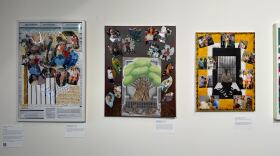A new online exhibit at the Smithsonian National Museum of the American Indian was prompted by the George Floyd protests in 2020. “Ancestors Know Who We Are” explores the experience of being both Black and Indigenous through poetry, paintings, drawings, and essays.
Two of the six artists are from the Puget Sound region, including multidisciplinary Seattle artist Storme Webber who is of Black and Alutiiq heritage.
Her featured poem “I Cover the Waterfront” evokes the memory of a local late-night diner, once a safe space for “two-spirit people” and people of color. Listen to an excerpt below.
Tacoma artist Paige Pettibon painted a black and white family portrait of her Coast Salish grandmother with her Black grandfather. She says making art helps her explore her own Afro-Indigenous heritage.
“I'm still figuring out what it means to reclaim my identities as being like someone who is fair skinned,” Pettibon said.
She hopes the exhibit helps others reflect on racial identity.
Exhibit curator Anya Montiel says the Washington state artists were chosen because they explored these themes at yəhaw̓, an Indigenous-centered exhibit hosted by the Seattle Office of Arts and Culture in 2019.
The exhibit will be available online for two years.






